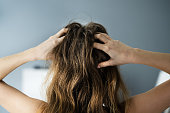Causes Of Hair Damage
There are many reasons for hair loss. The hair is based on a cut in which there are scales that connect the strands together.
1. Diet
There's a lot to the old saying, "You are what you eat," especially when it comes to hair and skin health.
Certain foods help hair grow and prevent breakage.
Adequate protein and antioxidants (found in plant foods) can also maintain hair health. Certain vitamins can also help with hair loss.
Certain foods help hair grow and prevent breakage.
Adequate protein and antioxidants (found in plant foods) can also maintain hair health. Certain vitamins can also help with hair loss.
2. Stress
There is a lot of evidence that there is a link between stress and hair loss, but it is also known that stress can cause hair breakage.
,
Telogen effluvium is a common type of alopecia that can be caused by stress. This type of stress causes the follicles to go dormant, so hairs that are in the middle of their growth period can fall out. You may also notice old hair loss.
3. Dryness
Improper hair can be a precursor to breakage and damage.
It can be caused by many factors, including dry weather, low humidity, and high temperatures. Make sure you use warm water and not hot water when you wash your hair - the latter can lead to frizz.
If the ends are dry, consider applying shampoo only to the scalp. A drop-in cooler isn't either. Try a hair mask on the middle and ends of your hair.
If you're pressed for time, apply a leave-in conditioner before shampooing wet hair.
. However, if you use this tool incorrectly or too much, the skin can be damaged by excessive heat.
One way to prevent heat damage in general is to give locks a break from all types of devices at least once a week. To really reduce heat damage from styling tools, choose ceramic models - they heat up well so you don't use the same part of the hair more than once.
It's also important to protect your hair before you heat it. Use a heat protectant to reduce damage.
4. Other prevention
Dauer, relaxers, professional hair straighteners and all colors can make your hair look good after the first one or two treatments. But if you do these things frequently, the curling iron can damage and damage your hair.
Permanent hair dye can interact with scalp and cause contact dermatitis.
The American Academy of Dermatology (AAD) recommends increasing the time between sessions to 8-10 weeks if possible. In the meantime, try a hair mask to get the best results.
5. Washing
If your skin is oily, there may be excess sebum (natural oil) production. This can cause you to try to wash your hair more often than you should.
Although daily washing is good if you have oily hair, you should not wash your hair more than once a day. On the other hand, dry hair only needs a weekly shampoo.
Also, make sure you gently brush your head and apply a gentle conditioner from the ends to the roots.
. But the motion of brushing the hair damages your hair when it is weak (when it is wet).
Instead of wiping the water from your head, wrap an absorbent towel around your hair. As a temporary, you can also leave the towel on your hair to get more water.
But let's face it, they come in handy on bad hair care days or when you're in a hurry.
The problem with hair ties is that they lift your head up and cut your hair. You may even feel that some hair falls out every time you wash its tail.
You can fix this by putting your hair in one motion, or by loosening your hair a little so that it doesn't pull your hair out too much.
also make sure you wear a good scrunchie and not just a plastic one that can damage your hair.
They only recommend massaging and massaging while you practice. , An older, reliable clinical trial from 2009 found that brushing teeth reduced hair loss in women.
Make sure you use a wide tooth comb to avoid breakage. Even with dry hair, use a brush and avoid using plastic. Try a natural bristle brush.
6. Hairlessness
It may seem that hair can be harmful. Surprisingly, cutting your hair can help keep your hair healthy and less prone to breakage.
You can think of a haircut as a haircut - in both cases, you need to remove some old cells to promote the growth of new ones. If you split these ends, the split ends can travel to the rest of your head and can cause a fracture.
Visit your stylist every eight weeks depending on your hair length and type. Even if you are growing your hair out, trimming damaged ends can prevent further breakage.
7. Hypothyroidism
We talk about hypothyroidism when the thyroid gland does not produce enough hormones. Although the thyroid gland itself is small, it plays an important role in the functioning of the body. This includes metabolism, heart rate and even hair growth.
People with hypothyroidism may experience excessive shedding and shedding, especially after bathing or brushing their teeth. If you have dry hair, along with low energy, sudden weight gain, and depression, see your health care professional for a thyroid test.
8. Eating Disorders
If you or someone you love has an eating disorder, hair loss is a possible symptom.
,
This is because some eating disorders cause malnutrition, such as anorexia and bulimia nervosa. In this case, the hair does not have the necessary nutrients to produce new hair, the process stops completely. You may even notice new hair fall in the middle of puberty.
Malnutrition can lead to serious consequences that require medical treatment. Reading personal stories of people who have overcome eating disorders can help you or a loved one seek treatment.




No comments:
Post a Comment
comment on my blog i will be thankful to you